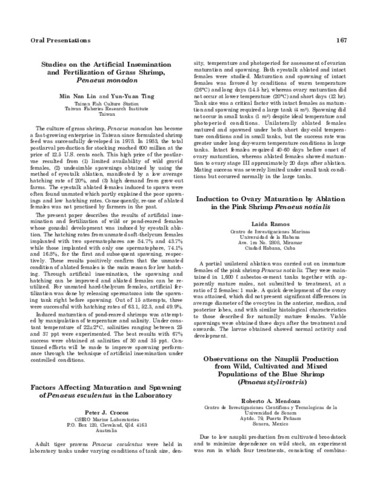Observations on the nauplii production from wild, cultivated and mixed populations of the blue shrimp (Penaeus stylirostris)
- Global styles
- MLA
- Vancouver
- Elsevier - Harvard
- APA
- Help
Share
Abstract
Due to low nauplii production from cultivated broodstock and to minimize dependence on wild stock, an experiment was run in which four treatments, consisting of combinations of 400 adult blue shrimp (Penaeus stylirostris) from wild and cultivated (F6) populations, were applied (wild females and males, wild females and cultivated males, cultivated females and wild males, and cultivated females and males). Females were inspected every third day. Those observed with spermatophores were captured and transferred to individual 100-ℓ spawning tanks. Water was treated with EDTA and erythromycin phosphate. More than 300 individual spawns were evaluated within a 180-day period. To evaluate the nauplii production per female, an analysis of variance for a factorial arrangement (43 × 2) was conducted. The factors considered were: the abovementioned treatments, different ovarian maturation stages, adhesion of the spermatophore, and kind of spawning (complete or partial). The mixed populations had higher nauplii production than the cultivated broodstock. All the females were tagged around an eyestalk and examined for rematuration. Up to six rematurations per female were registered as well as a minimum of four days between successive spawnings for the same female. The effect of rematuration on the quantity of nauplii is discussed. Gonadosomatic index for wild and cultivated females is compared. Selective criteria for spawners are given.
Description
Abstract only.
Suggested Citation
Mendoza, R. A. (1985). Observation on the nauplii production from wild, cultivated and mixed populations of the blue shrimp (Penaeus stylirostris ) (Abstract only). In Taki Y., Primavera J.H. and Llobrera J.A. (Eds.). Proceeding of the First International Conference on the Culture of Penaeid Prawns/Shrimps, 4-7 December 1984, Iloilo City, Philippines (pp. 167-168). Iloilo City, Philippines: Aquaculture Department, Southeast Asian Fisheries Development Center.
Type
Oral presentationISBN
9718511008



